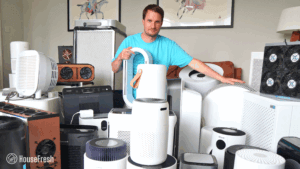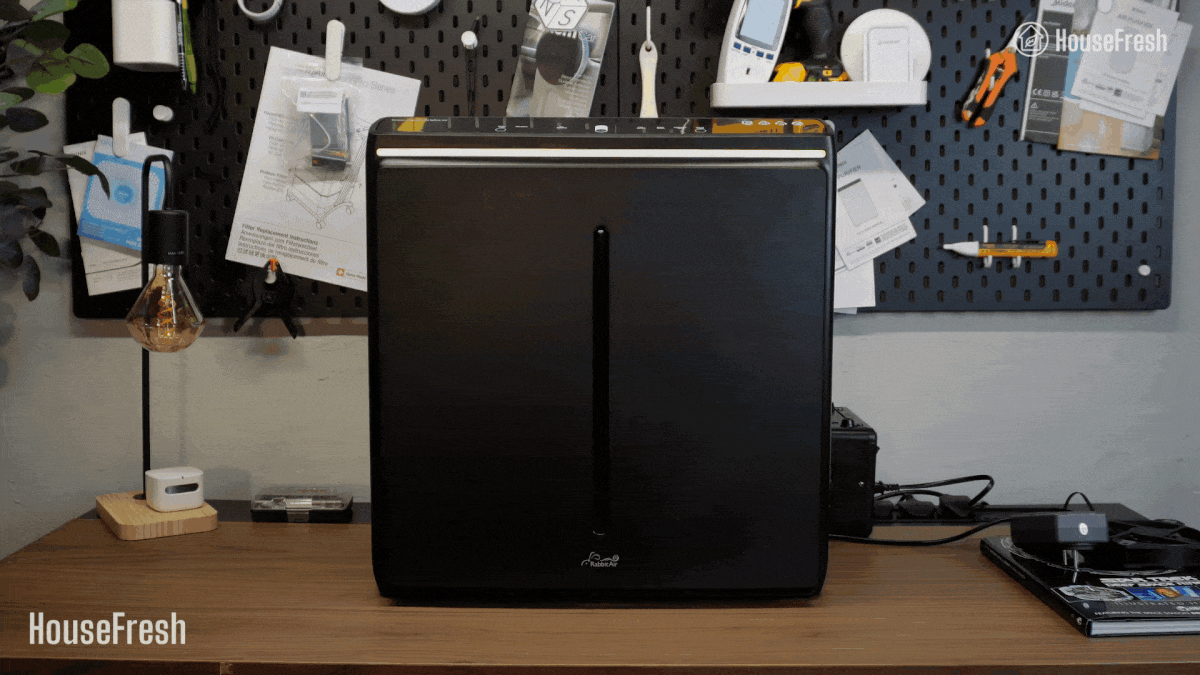According to the CDC, 11.6% of all adults in the U.S. smoke cigarettes and 3.7% smoke cigars; if that’s you, then you most likely don’t mind the odor, but that potent smoke can travel far.
Cigar and cigarette smoke can enter your home from neighbors or even from one person smoking as they walk by. The smell is pervasive and can make it hard to sleep or spend time in a room where the smoke has invaded.
We all know the dangers of secondhand smoke. Still, smoke particles from cigarettes can even cause thirdhand smoke, a residue of toxic particles that becomes embedded in furniture, carpet or walls. Thirdhand smoke particles can last for years and remain toxic as long as they are in your home.
While there are things you can do to clear smoke from a room, a long-term, effective solution is to get an air purifier. This will allow you to remove smoke particles and odors before they cause harm.
Cigarette smoke is one of the hardest pollutants to remove, so I included only air purifiers that excelled across all our tests and contained larger amounts of pelleted activated carbon.
The best air purifiers for cigarette and cigar smoke
For those who don’t want to read the whole thing, here is a quick recap of all the models I shortlisted with a top-level view of the specs for each one:
| BEST OVERALL | FOR LARGE SPACES | FOR SMART | BUDGET OPTION | THE MOST CARBON | |
|---|---|---|---|---|---|
| IQAir HealthPro Plus | Smart Air Blast Mini | Alen 45i | Levoit Core 600S | Austin Air HealthMate | |
 |  |  | 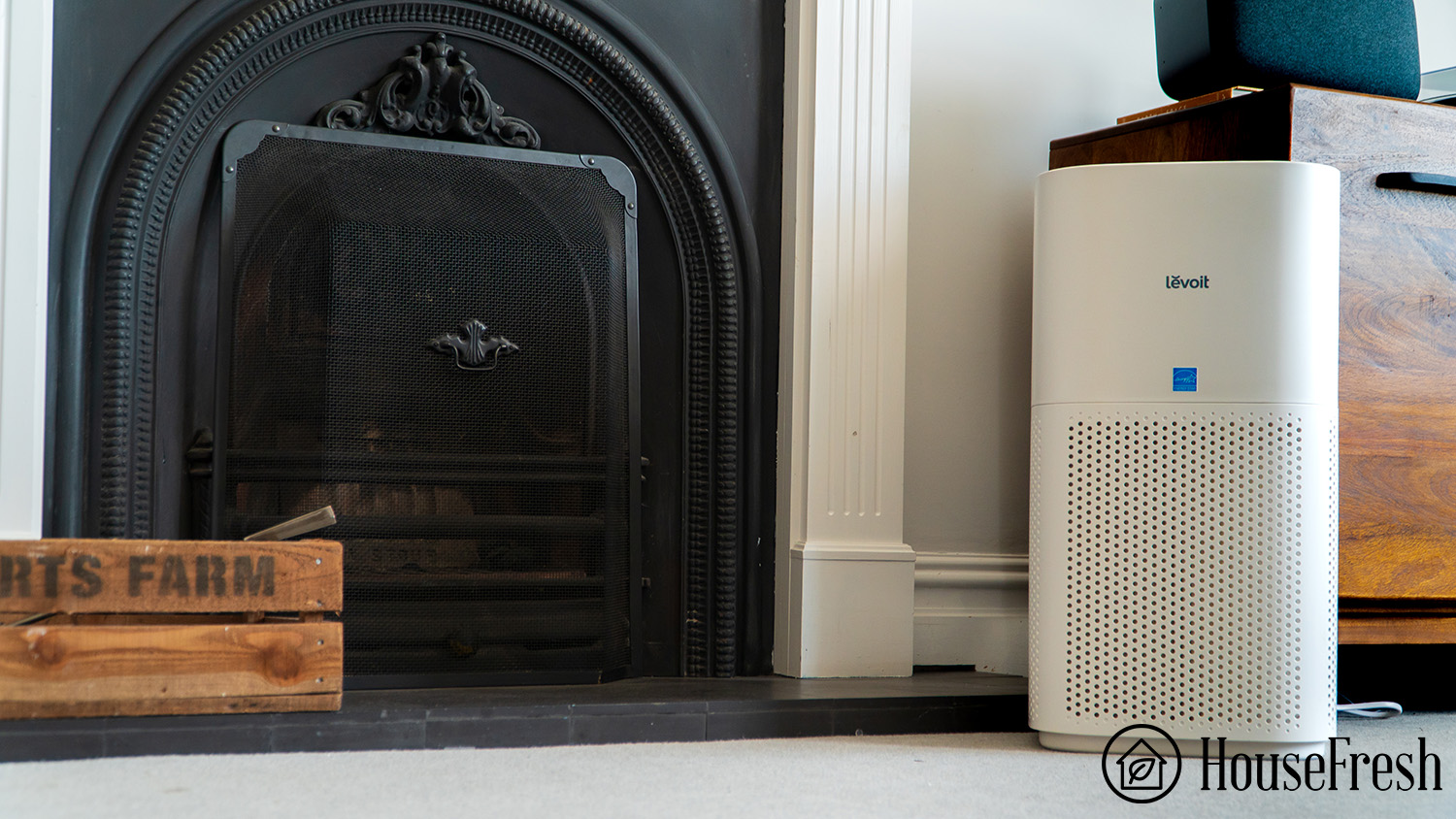 |  | |
| Time to PM1 zero | 28 minutes | 15 minutes | 30 minutes | 22 minutes | 38 minutes |
| CADR | 250 CFM | 450 CFM | 209 CFM | 410 CFM | 150 CFM |
| Filter tech | HyperHEPA + V50-CELL carbon | H13 HEPA w/ optional carbon filter | HEPA + carbon filter with odor catalyst | Bonded particle + carbon filter | HEPA + carbon filter |
| Carbon Amount | 5lbs | 1.56lbs | 2.38lbs | 0.79 lbs | 15lbs |
| Max room size (5 ACH) | 375 sq. ft. | 703 sq. ft. | 297 sq. ft. | 584 sq. ft. | 234 sq. ft. |
| Long-term running costs | $421.47 / year | $311.89 / year | $136.64 / year | $125.23 / year | $283.03 / year |
| List price | $1,199.99 | $599.00 | $498.00 | $299.99 | $765.00 |
You should know that no consumer air purifier can reduce the risk of lighting a cigarette in your room. There are many dangers of this beyond just the particles and odors, and we recommend you always go outside or, if you have the funds, look at a commercial smoke eater device, but be aware that you are looking at costs of $3k and up.
Be sure to check out the full article below for a more comprehensive guide to the five recommended air purifiers and why they’re good options against cigarette smoke.
1. Best overall: IQAir HealthPro Plus (with V5 Cell Filter: 5.5 lbs carbon)
Powered by a HyperHEPA filter and more than five pounds of activated carbon to deal with smoke particles and odors.
The IQAir HealthPro Plus is big. It needs to be big to accommodate three stages of air filtration: a thick pre-filter for large particles and debris, a lab-certified HyperHEPA for fine and ultra-fine particles, and a massive gas filter with activated charcoal and zeolite for VOCs and unwanted smells.
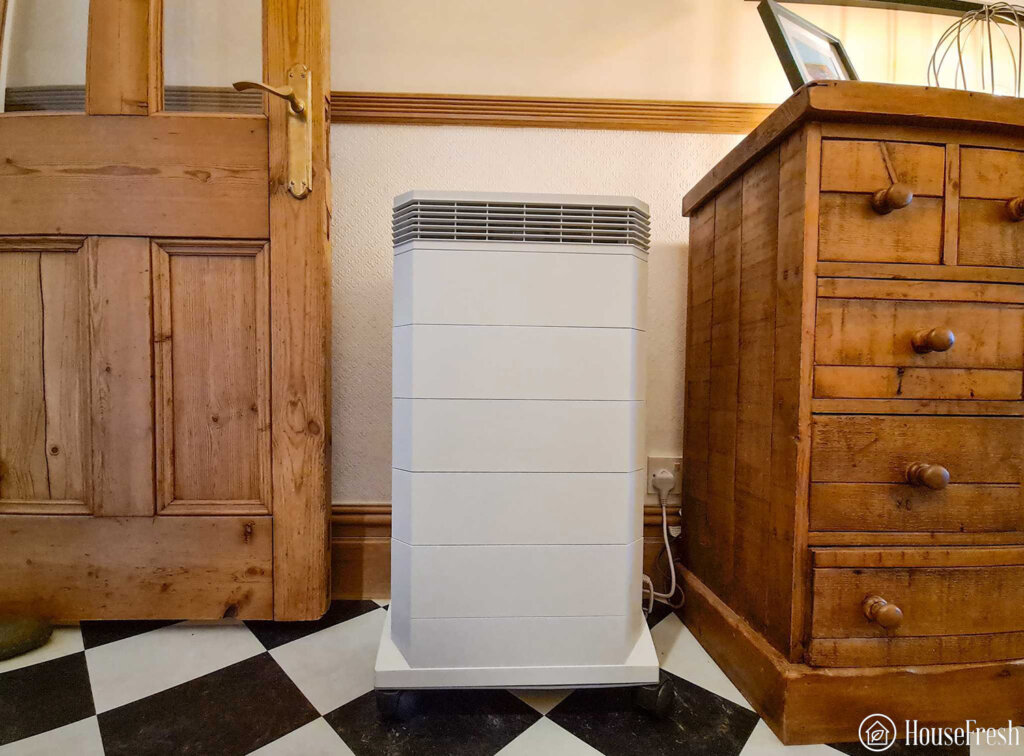

Even with such a dense set of filters, it still managed to clean our test room in 28 minutes in our particle removal test. This showcases how powerful its fan is at drawing the air in, which could translate to a noisy air purifier, but luckily, it doesn’t: the HealthPro Plus only generates 36.9 dB of noise output at its lowest fan speed and 61.2 dB when operating at top speed (which is the mode you should run it in to remove cigar or cigarette smoke effectively).
What we really like
What we think could be better
The HealthPro Plus is a long-term investment, costing nearly $900. If I were forced to choose one air purifier, this is the device I would pick — especially when dealing with any type of smoke. IQAir has so much trust in its unit that they locked their CEO inside a smoke chamber with just the HealthPro Plus to clean the air as he breathed.
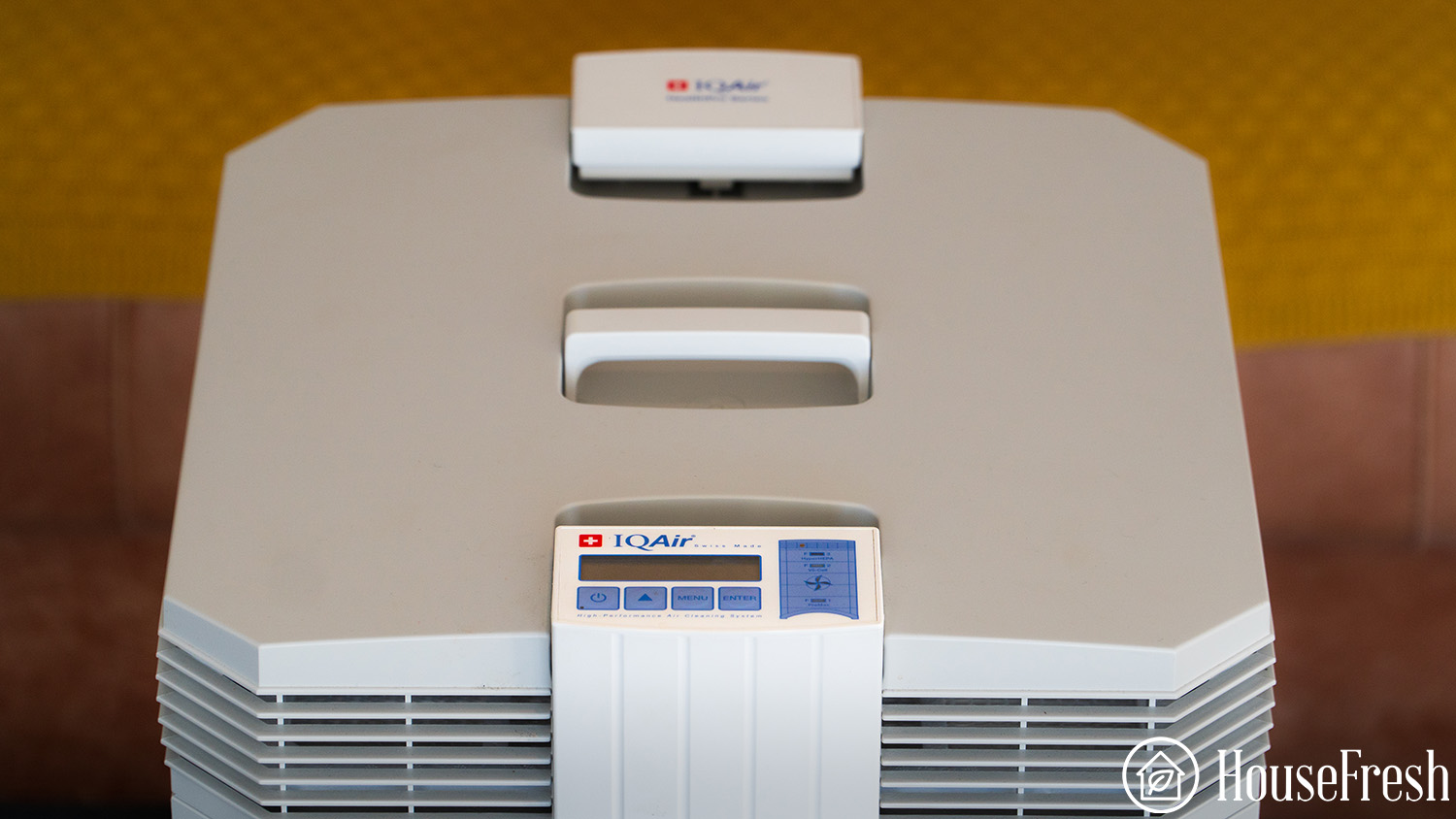
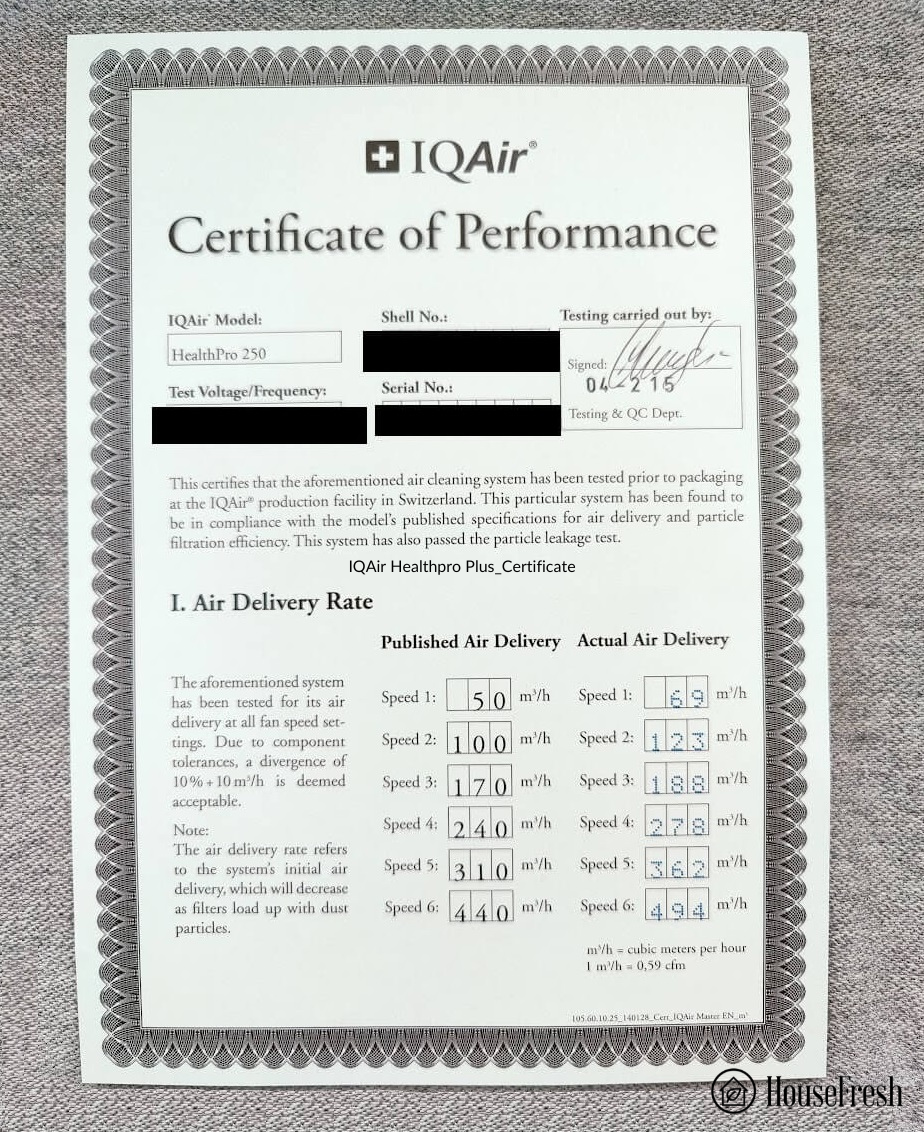
| Clean air delivery rate (CADR): | – Top speed PM1 CADR: 213 cfm – Sub-45 dBA PM1 CADR: 86 cfm |
| Filter technology: | HyperHEPA and V50-CELL with 5lbs of activated carbon + zeolite mix |
| Recommended room size: | 319 sq. ft. (5 air changes per hour) |
| Dimensions: | 28H x 18W x 16D inches (71H x 38W x 41D cm) |
| Weight: | 35 lbs (15.88 kg) |
| Noise level in decibels from 3 ft. away: | Speed 1: 36.9 dB Speed 2: 37.2 dB Speed 3: 40.9 dB Speed 4: 47.2 dB Speed 5: 53.9 dB Speed 6: 61.2 dB |
| Electricity consumption in watts: | Standby mode: 1 watts Speed 1: 16.5 watts Speed 2: 32.7 watts Speed 3: 47.3 watts Speed 4: 69 watts Speed 5: 94.3 watts Speed 6: 145.2 watts |
| Filter lifespan: | 4 years |
| Manufacturer’s warranty: | 10 years |
| Country of origin: | Switzerland |
| Country of manufacture: | Germany |
2. Best for large spaces: Smart Air Blast Mini (with Carbon Filter: 1.56 lbs carbon)
Unmatched in speed, the Blast Mini can quietly clean the air of rooms of up to 700 sq. ft.
As the fastest unit we tested, Smart Air’s Blast Mini only needed 15 minutes to bring PM1 levels down to zero in our test room. The exact kind of air cleaning performance you need, considering how fast tobacco smoke and toxic particles spread through entire homes.

The Blast Mini also has one of the biggest HEPA filters ever. The H13 grade filter can trap fine and ultra-fine particles on its large surface, lasting up to 13 months. It also features a removable pre-filter but you’ll need to purchase the optional activated carbon filter to tackle cigar/cigarette smells and chemicals. Considering the 1.56 lbs of loose-fill activated carbon packed in the filter, it’s worth the while.
What we really like
What we think could be better
Despite being a considerably large air purifier, the Blast Mini’s design is modern and can blend in easily. It may lack the bells and chimes of other top-tier units. Instead, it has just a straightforward one-dial command to navigate between speeds. The Smart Air team focused on outstanding air cleaning performance, and the Blast Mini simply excels.
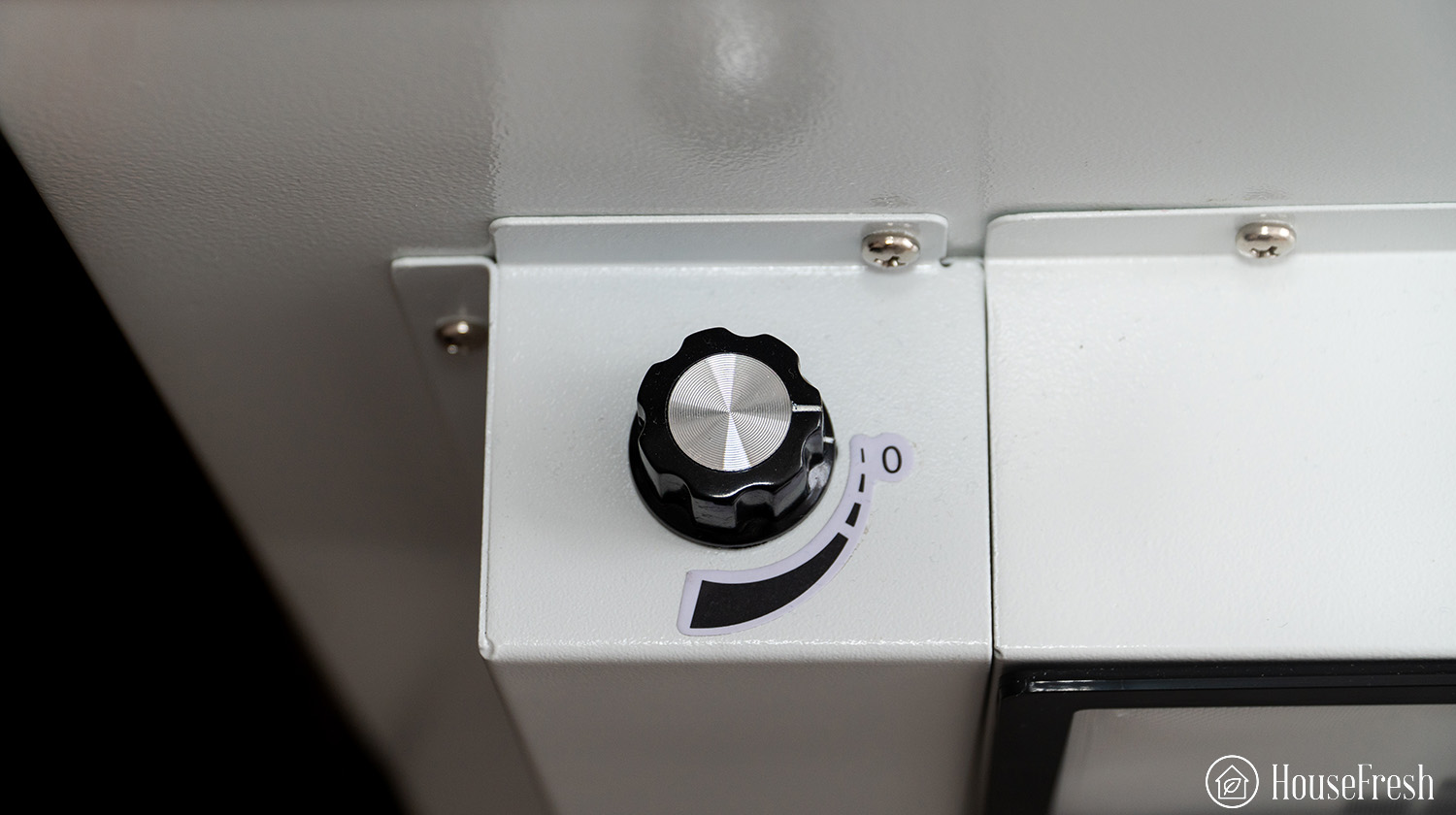

| Clean air delivery rate (CADR): | – Top speed PM1 CADR: 400 cfm – Sub-45 dBA PM1 CADR: 272 cfm – Manufacturer provided CADR: 437 cfm |
| Filter technology: | H13 HEPA filter (and optional pelleted activated carbon filter) |
| Recommended room size: | 600 sq. ft. (5 air changes per hour): |
| Dimensions: | 22.6L x 13W x 24.8H inches (57.5L × 33W × 63H cm) |
| Weight: | 59 lbs (26.8 kg) |
| Noise level in decibels from 3 ft. away: | Speed 1: 44.9 dB Speed 2: 51.2 dB Speed 3: 56.3 dB |
| Electricity consumption in watts: | Standby mode: 0 watts Speed 1: 51.9 watts Speed 2: 87.4 watts Speed 3: 122.7 watts |
| Filter lifespan: | 13 months |
| Manufacturer’s warranty: | 1 year |
| Country of origin: | China |
| Country of manufacture: | China |
3. Best for smart features: Alen 45i (with VOC/Smoke Filter 2.38lbs)
Alen brings a high-end laser sensor with a sizeable standard carbon filter


The Alen 45i is the mid-size model in the Breathsmart range. When you choose the VOC/Smoke filters, you can get 2.38 lbs/1079g of activated carbon to deal with the gases that come from smoke and the particles that the H13 HEPA filters will pick up.
We can compare these carbon amounts to other air purifier models:
| Air Purifier Model | Carbon Amount |
| Winix 5510 (Filter Q) | 226g |
| Alen 45i (Fresh Filter) | 299g |
| Levoit Core 400S (Basic Filter) | 240±10g |
| Levoit Vital 400S (Smoke Filter) | 450g |
| Dyson Big+Quiet BP06 | 900g |
| Alen 45i (VOC/Smoke Filter) | 1079g |
Be aware that the VOC/Smoke filter will reduce overall particle removal performance compared to particle-only. Still, as you can see from the table above, this is the most significant amount of carbon you can get with a standard mid-size air purifier.
We are featuring it in this list of the best innovative models for smoke because it comes with a high-end Plantower sensor, the PMS-7003, which can detect pollutants within seconds and enable the air purifier to move to higher fan speeds to remove the contaminants quickly.

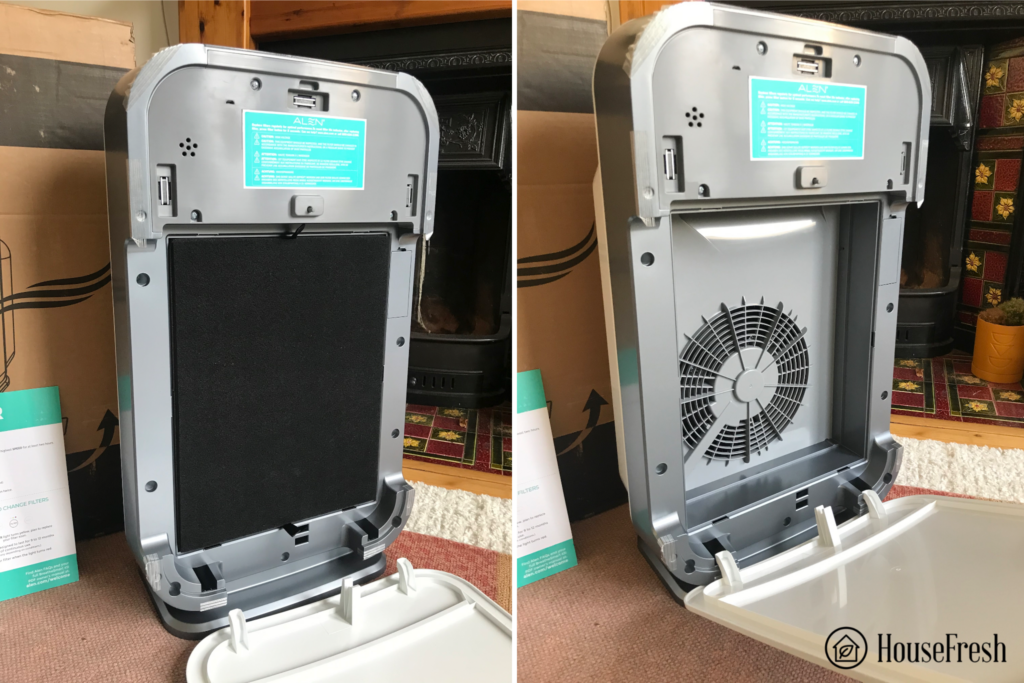
What we really like
What we think could be better
When testing particle performance with the Pure filter, it managed to clean our test room in 30 minutes and even when running on speed 2 it was less than 45dBA at 3 feet away, yet still managed to clean our test room of all PM1 in 30 minutes.
| Clean air delivery rate (CADR): | – Top speed PM1 CADR: 198 cfm – Sub-45 dBA PM1 CADR: 123 cfm – AHAM PM2.5 CADR: 207.9 cfm (dust) |
| Filter technology: | True HEPA H13 filter with activated carbon pellets + Ionizer technology |
| Recommended room size: | 297 sq. ft. (5 air changes per hour) |
| Dimensions: | 25H x 15W x 8.5D inches (63.5H x 38.1W x 21.6D cm) |
| Weight: | 15 lbs (6.80 kg) |
| Noise level in decibels from 3 ft. away: | Speed 1: 36.2 dB Speed 2: 42.2 dB Speed 3: 51.1 dB Speed 4: 56.1 dB |
| Electricity consumption in watts: | Standby: 0.8 watts Speed 1: 4.4 watts (5.1 w/ionizer) Speed 2: 9.3 watts (10.1 w/ionizer) Speed 3: 22.3 watts (22.8 w/ionizer) Speed 4: 38.5 watts (38.7 w/ionizer) |
| Filter lifespan: | 9-12 months |
| Manufacturer’s warranty: | Lifetime (with product registration & active filter subscription) |
| Country of origin: | United States |
| Country of manufacture: | China |
4. Best budget option: Levoit Core 600S (with Smoke Removal filter: 0.79 lbs carbon)
Ideal for medium to large-sized rooms, the Levoit Core 600S has all the smart features of top-tier air purifiers, a good amount of activated carbon and a budget-friendly price tag.
The Core 600 is a speedy unit that finished our cleaning speed test in only 15 minutes. As the biggest unit in Levoit’s Core range, it is also suitable for large spaces up to 600 sq. ft. rooms. Yet, its energy consumption is among the lowest on this list ($75 per year), only bested by the smart Mila ($58).

Levoit’s three-stage filters feature a non-removable pre-filter and the primary filter for fine particles and activated carbon. I recommend the Smoke Remover filter for cigar and cigarette smoke, as it has the highest amount of carbon in the Core series range. It is more expensive than regular filters—it will cost $160 a year, considering they last 6 months—but you get 0.79 lbs of pelleted carbon.
What we really like
What we think could be better
The Core 600S is one of the best high-performing air purifiers in the budget range. Compared to other large units, it has an outstanding cost-per-CADR ratio and offers a solid mix of cleaning power and smart features for less than $300.


| Clean air delivery rate (CADR): | – Top speed PM1 CADR: 375 cfm – Sub-45 dBA PM1 CADR: 156 cfm – AHAM PM2.5 CADR: 398 cfm (dust) |
| Filter technology: | Bonded particle filter with a layer of pelleted activated carbon and a pre-filter mash wrap. |
| Recommended room size: | 562 sq. ft. (5 air changes per hour) |
| Dimensions: | 12.3 x 12.3 x 23.6 inches (31.3 x 31.3 x 60 cm) |
| Weight: | 13.7 lbs (6.2 kg) |
| Noise level in decibels from 3 ft. away: | Sleep: 37.9 dBA Speed 1: 44.4 dB Speed 2: 45.9 dB Speed 3: 53.8 dBA Speed 4: 62.3 dBA |
| Electricity consumption in watts: | Standby mode: 1.3 watts Sleep: 4.33 watts Speed 1: 7.46 watts Speed 2: 10.7 watts Speed 3: 20.29 watts Speed 4: 48.1 watts |
| Filter lifespan: | 6-12 months |
| Manufacturer’s warranty: | 2 years |
| Country of origin: | United States |
| Country of manufacture: | China |
5. Best carbon filter: Austin Air HealthMate (with 15 lbs of carbon)
One of the few (and best) USA-made air purifiers with an activated carbon filter like no other, perfect for removing VOCs and toxic chemicals.
Although you’ll miss some perks with the Austin Air HealthMate, such as smart features or an auto mode, it has a seriously robust filter with four stages of pure mechanical filtration. With no more than one dial to navigate through fan speeds, this heavy-duty unit is straightforward to the core.

The real substance is in the medical-grade HEPA filter and massive activated carbon filter, ideal for tackling the finest particles and VOCs of cigar and cigarette smoke. Then, unlike other air purifiers, the Austin Air HealthMate has two pre-filtering stages, one for large-sized and the other for medium-sized particles that would otherwise clog the main filter faster — as a matter of fact, the HealthMate filter has an impressive lifespan of five years.
What we really like
What we think could be better
During performance tests, the Austin device removed all PM from our room in 37 minutes. True, it could sound unimpressive compared to the speedy and budget-friendly Levoit Core 600. But, then, there’s no comparison to the activated carbon filter this unit is packed with — not even the IQAir Healthplus Pro has as much. No air purifier beats the Health Mate in dealing with VOCs.
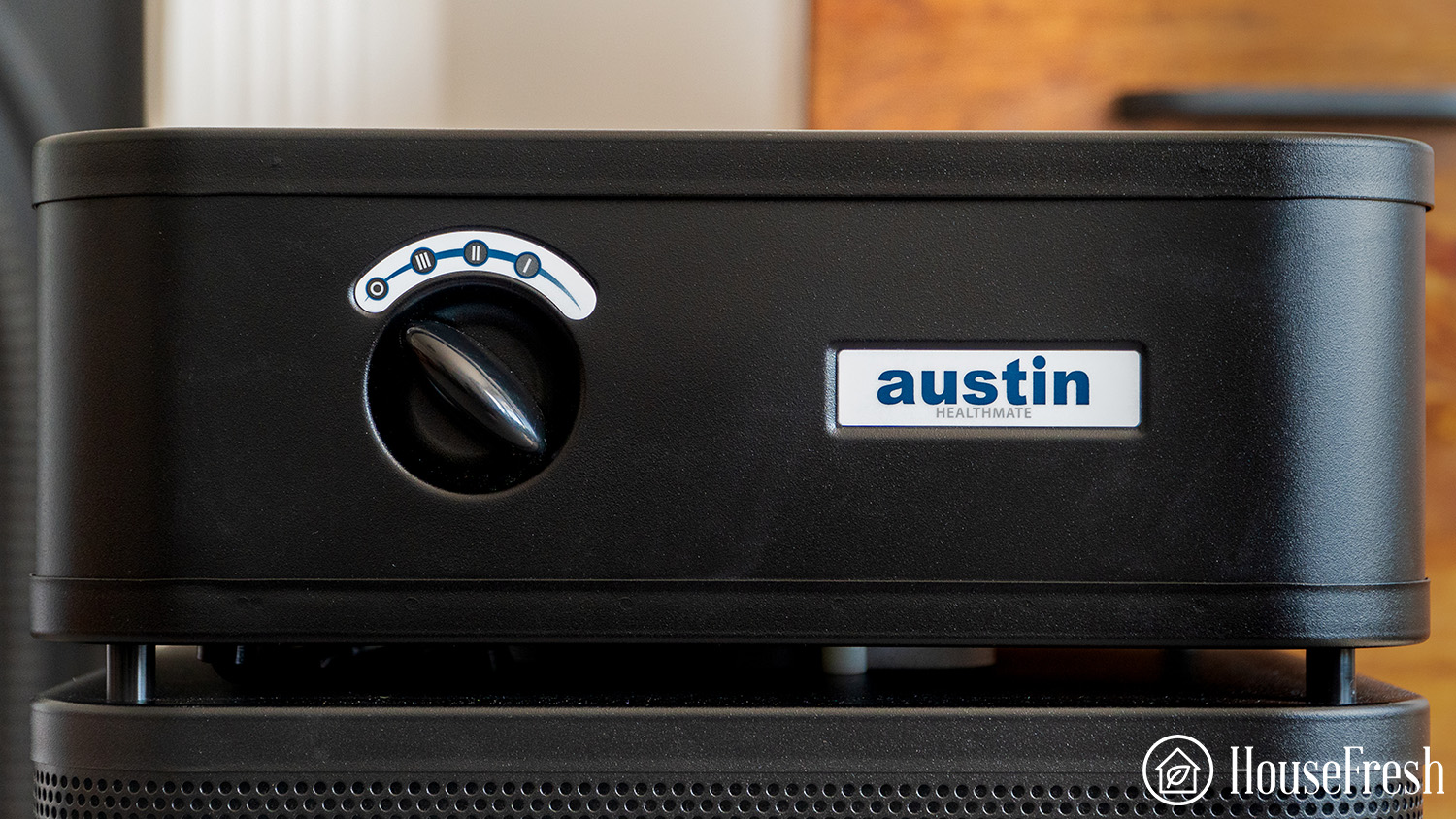

| Clean air delivery rate (CADR): | – Top speed PM1 CADR: 156 cfm – Sub-45 dBA PM1 CADR: 77 cfm – AHAM PM2.5 CADR: 154 cfm (dust) |
| Filter technology: | HEPA particle filter with 15 lb of activated carbon and zeolite mix gas filter |
| Recommended room size: | 234 sq. ft. (5 air changes per hour) |
| Dimensions: | 23H x 14.5W x 14.5D inches (58.4H x 36.8W x 36.8D cm) |
| Weight: | 20.41 lbs (9.26 kg) |
| Noise level in decibels from 3 ft. away: | Speed 1: 42.5 dB Speed 2: 53.2 dB Speed 3: 61.5 dB |
| Electricity consumption in watts: | Standby mode: 0 watts Speed 1: 61.1 watts Speed 2: 85.05 watts Speed 3: 147.6 watts |
| Filter lifespan: | 5 years |
| Manufacturer’s warranty: | 5 years |
| Country of origin: | United States |
| Country of manufacture: | United States (Buffalo, New York) |
Units we don’t recommend for cigarette and cigar smoke:
- PuroAir 240 – This is a hyped unit that simply lacks the performance to back it up. Smaller devices like this have very low CADR and small amounts of carbon so will lose effectiveness quickly with a pollutant like cigarette smoke.
- Levoit LV-H132 – I was shocked to see this device recommended for smoke by a well-known magazine. While it’s cheap, its performance in our particle removal test was very poor. It took 1 hour and 38 minutes to make our test room clean. It is underpowered for most situations, but it would be dangerous if you relied on it to remove smoke.
- Okaysou AirMax 10L Pro – A super popular air purifier thanks to its slick use of TikTok influencers, but it failed to match our expectations. It cleaned our test room in 4 minutes, longer than the much cheaper Core 300, and it made claims about its 5-in-1 filter technology that weren’t true.
- Dyson HP04 – A high price for a good-looking device, but it has a very small CADR, and it took 1 hour and 24 minutes to clean all pollutants measuring 1 micron in our test room. This will be nearly useless for smoke issues unless you like the fan function.
- Levoit LV-H128 – At less than $40, this is a great price but a terrible air purifier as it took 2 hours and 42 minutes to clean our test room of 728 cubic feet of particle pollutants measuring at least 1 micron. It will be totally useless for any-sized room to deal with smoke from cigarettes and cigars.
- Molekule Air Mini+ – You have probably seen adverts for this good-looking device from Molekule. We were a little suspicious of its PECO technology, and it took almost an hour to bring down the levels of PM1 to breathable levels. At this price level, it’s just a total waste of money, and you are better off with any of the other air purifiers we recommend. There is even a class action settlement in progress for devices sold by this brand.
What to look for when buying an air purifier for smoke
1. 4.8 air changes per hour in your room
Many air purifier manufacturers overstate the room size they can work in. While AHAM requires room sizes to be based on 4.8 air changes per hour, many brands will give the room size for 1 air change.
Be very wary of manufacturers who don’t provide a CADR rating or don’t send their devices to AHAM for testing, as we have seen many of these devices exaggerate their performance when we test them ourselves.

One air change is almost useless, especially with something as pervasive as cigarette or cigar smoke.
That is why when we list room sizes, we always base them on their reported CADR and the maximum size when providing at least 4.8 air changes per hour.
To make things simpler, we produced a tool that tells you the CADR in CFM you need for your room size – enter your room size and adjust the ceiling height if required and our tool will let you know what CADR is needed:
2. Large Carbon is necessary for gas and odors
You will want to look at HEPA-grade filters to deal with tiny particles that can measure as small as 0.1 microns. HEPA H13 filters are tested to be 99.97% efficient at capturing particles 0.3 µm in size. HEPA H13 is used extensively in marketing material, but most manufacturers don’t share third-party testing. One of the reasons I am a big fan of IQAir is that they share all their third-party lab data, so you can be confident that all of their filters have been tested to this grade.
Besides, other types of filter technology can sometimes make the air quality worse, but in nearly all cases, they promise a lot but fail to deliver. Just stick with HEPA, it’s backed by decades of research and has no chemical byproducts.

While HEPA does a great job of removing the tiniest particles from the air, odors and gases will pass through. You will need a good-sized activated carbon filter to deal with gases and odors such as those from cigarette or cigar smoke.
When it comes to activated carbon, bigger is better, which is why the top two choices we recommend for dealing with smoke are to measure their carbon filters in lbs.


Look for activated carbon filters that use pellets of actual carbon. They will last much longer and are much more effective at removing odors.
Be wary of the fabric carbon filters you see on devices from Blueair, as they will quickly lose effectiveness.
3. Decide on what features you need


Many newer air purifiers have app support, onboard sensors and auto-modes that kick in when the sensor detects pollutants like particles or gases. If you want auto-mode, try to choose a model that uses a laser sensor vs cheaper optical sensors, as they don’t need maintenance and will kick in within seconds of detecting particles in your air. The Alen 45i and Core 600S on our list have a high-end laser sensor.
You will have to leave your device running continuously for regular smoke issues, so these features might not be as helpful as those who want an air purifier for occasional cooking odors.
For those who like their devices to be smart, our current top favorite is the 45i. It has a high-end app combined with a laser sensor and you also get a lifetime warranty if you use your Alen filters with your device.
How we test air purifiers
Saying we tested 104 air purifiers in the last four years sounds great, doesn’t it? But what does testing mean for HouseFresh?
It’s definitely not just getting the units out of their boxes to take some cool editorial pictures for our articles. On the contrary, it is a thorough process that involves reliable testing devices to cover the many aspects of air purifier evaluation.
Air cleaning performance is key, for sure. But we go further. When you decide to invest in an air purifier that will be constantly running at home, things like long-term costs and noise output are also important in a real-world context.
Our testing process includes the following steps:
Step 1. We conduct a particle removal test
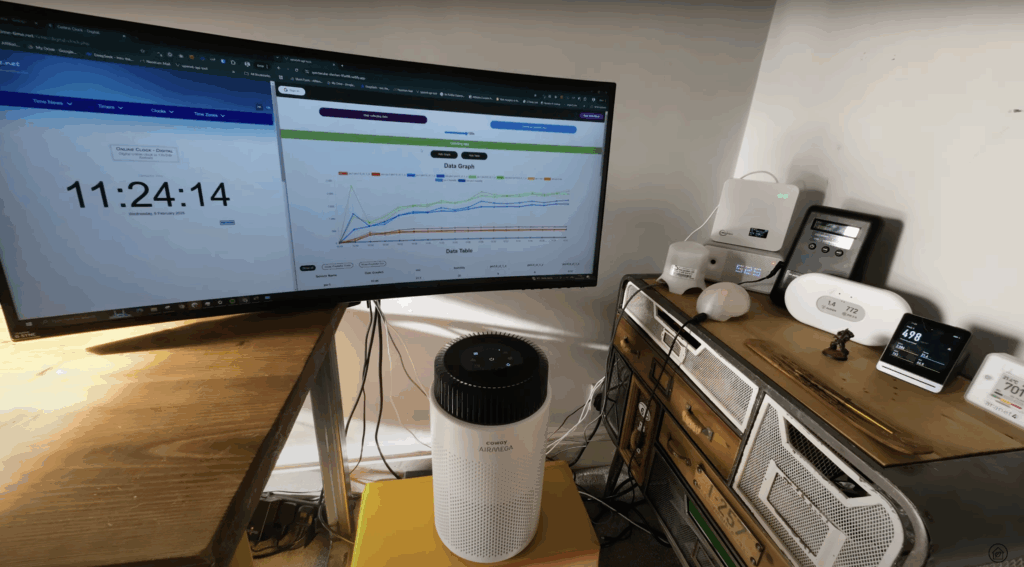
First, we burn some incense to pollute the air. Using our PurpleAir indoor sensor (which we’ve chosen after thorough research), we measure how fast each unit can remove PM10, PM1 and PM2.5 at top fan speed. The PurpleAir sensor provides regular updates on particulate matter levels, allowing us to create graphs showing the evolution of air quality in the room.
Step 2. We assess the power of the fan

We also measure the unit’s fan power with the Testo 410i anemometer. It’s interesting to see the variation in airflow coming out of the unit at every fan speed. Especially considering the AHAM Verified program measures CADR at the highest speed setting.
Step 3. We measure sound levels generated
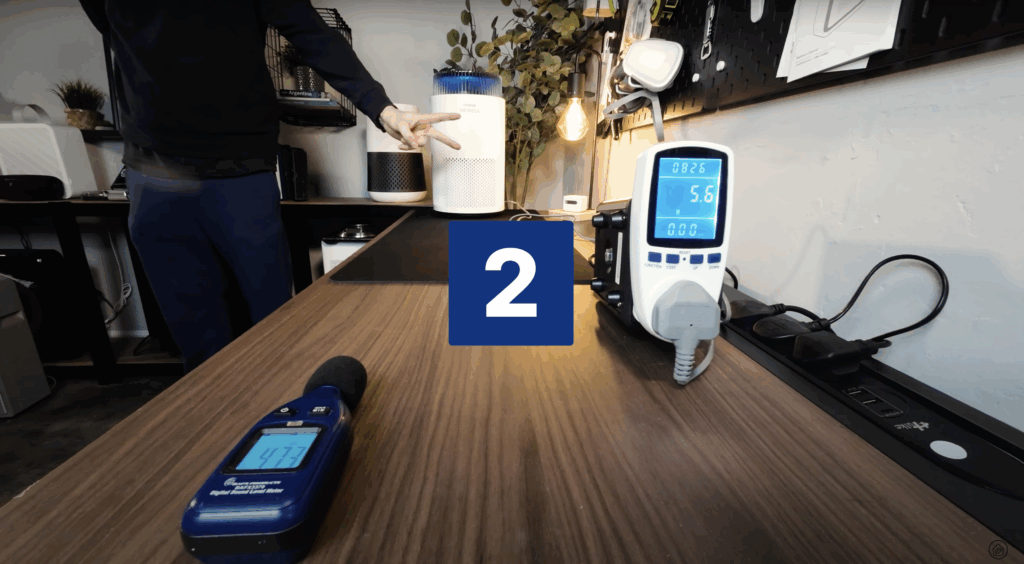
For noise levels, we use a commercial sound meter from 3 ft. away to measure how much noise in decibels (dB) is generated by the air purifier at each fan speed. Like other measurements, the data is displayed in our reviews, but we also share the results on HouseFresh YouTube channel.
Step 4. We measure electricity consumption

We use a power meter to record how much electricity (in watts) the air purifier consumes when running at each of its fan speeds, including sleep mode and stand-by mode.
Step 5. We estimate yearly maintenance costs
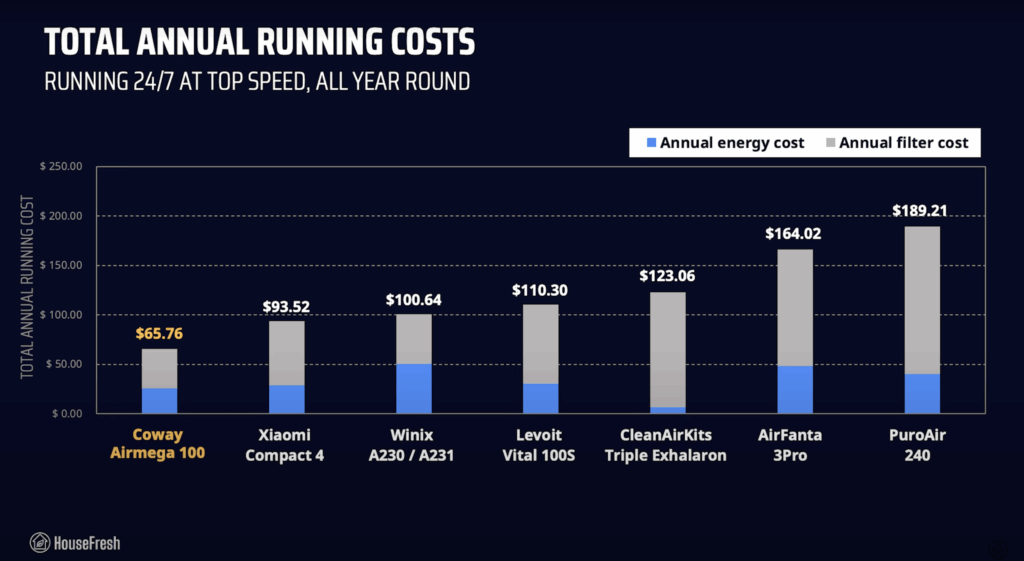
We also calculate the long-term costs you can expect to spend each year to run the air purifier. First, we use the appliance energy calculator from the U.S. Department of Energy to calculate how much money running the air purifier will add to your yearly energy bill. Next, we conduct desk research to determine the costs of genuine and generic replacement filters, using filter lifespan information stated by the manufacturer.
Step 6. Real-life experience
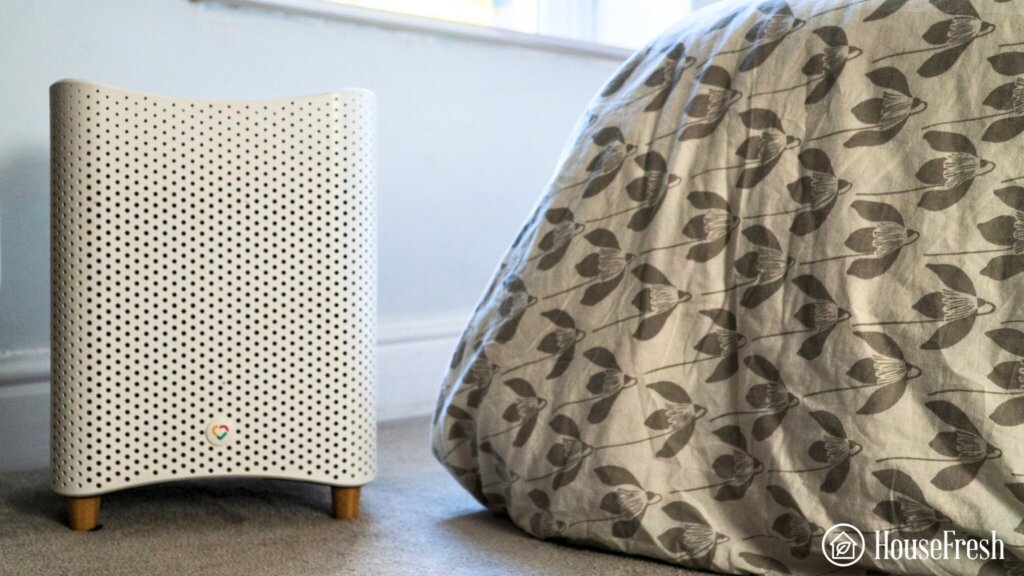
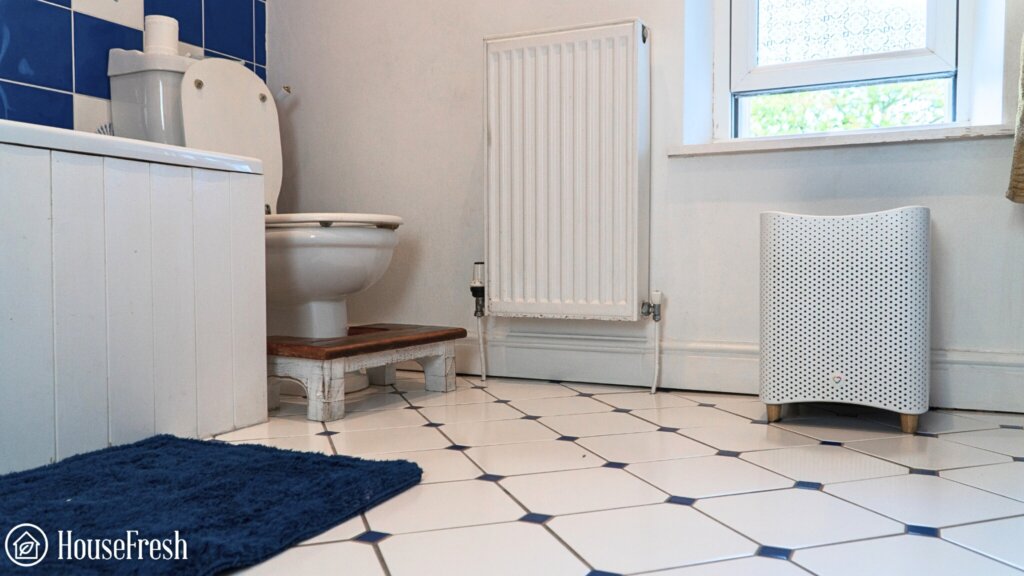

All four steps comprise the core performance evaluation we run on every unit. We know the data is solid. However, there’s something about everyday use that cannot be measured in a lab-test situation. That is why our “final step” is using the air purifier regularly at home in an ordinary context. You can learn a lot by just living with a device.
Wrapping up
I’ve intentionally selected various air purifiers for cigar or cigarette smoke. It’s a serious issue and you should be able to find a unit to fit your circumstances, budget and needs.
Whether you found the unit that sounds right for you in this guide or will keep browsing the internet for other options, make sure to check if the one that catches your eye is powerful enough, has the right CADR to clean your space, has a high-performance primary filter and features an activated carbon filter (the more, the better) for fumes and VOCs.
My goal is to help more people improve their indoor air quality. So, if you have any doubts about our testing process or have a question that I haven’t covered in this guide, please feel free to email me directly: danny@housefresh.com
June 23rd, 2025:
- Fixed typos
- Added ‘Jump to’ sections
May 12th, 2025:
- We removed the Mila air purifier because we found the performance and overall design of the Alen Breathsmart 45i to be of better value.
- Updated data points with our latest test results
- Improved guide to focus on carbon filter sizes
- Added performance data charts from Flourish
- Added detail on how we test air purifiers


